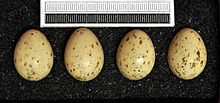Blue magpie
| Blue magpie | ||||||||||||
|---|---|---|---|---|---|---|---|---|---|---|---|---|

Blue Magpie ( Cyanopica cyana ) |
||||||||||||
| Systematics | ||||||||||||
|
||||||||||||
| Scientific name of the genus | ||||||||||||
| Cyanopica | ||||||||||||
| Bonaparte , 1850 | ||||||||||||
| Scientific name of the species | ||||||||||||
| Cyanopica cyana | ||||||||||||
| ( Pallas , 1776) |
The blue magpie ( Cyanopica cyana ) is a species of bird that is native to the Iberian Peninsula and East Asia.
Appearance
The 33–37 cm long blue magpie is very similar in its physique to the magpie , but its legs and beak are proportionally somewhat shorter.
It has a brownish gray to beige colored belly. The back is darker to brown, the brownish color changes in places into the blue of the wings. The top of the head is glossy black. The white color of the throat extends in a narrow, lateral band down to the neck. The tops of the wings and the tail are azure and gave it its name. The tip of the tail is colored lighter to white. The blue of the wings and the tail are the structural colors typical of corvids , i. H. With a suitable incidence of light, it can appear bright azure blue, in bad weather it can be more muted.
Distribution and existence
The distribution area of the blue magpie is divided into two widely spaced disjoint sub-areas. One is located in southwestern Europe on the Iberian Peninsula, the other, much larger, in East Asia. There, the species populates Japan, Korea, large parts of China, northern Mongolia and southern Siberia.
Only one of the eight subspecies - C. c. cooki - occurs in Europe. There are several theories about the origin of this exclave .
On the one hand, it is assumed that there used to be a continuous population between the Mediterranean basin and East Asia. The glaciation during the Ice Age led to a decline in the population and to a division of the distribution area. Another theory assumes that the European population is not autochthonous and that the pretty bird was introduced by Portuguese sailors in historical times (around the 16th century). Since the cooki subspecies was described as early as 1830 and differentiated from other subspecies, there are justified doubts about this theory: It is unlikely that such a clear split has taken place in the course of 200 years.
According to recent genetic studies, the European population differs so clearly from the East Asian population that it forms its own species - Cyanopica cooki . However, this has not yet been officially recognized.
According to the European Bird Census Council, the European population in Portugal and Spain is between 260,000 and 460,000 breeding pairs. The stocks are stable.
habitat
The blue magpie is a typical bird of the open tree landscapes on the Iberian Peninsula, it often occurs in the open, evergreen forests of cork and other oak species (e.g. holm oak , Pyrenees oak ), light pine groves , pine-oak mixed forests as well Pine forests (e.g. Aleppo pine ).
It prefers less closed forest areas than the extensively used cultural landscape interspersed with pasture land or fruit crops. It therefore reaches particularly high population densities in Extremadura , western Andalusia and southern Portugal .
On the edge of its range, the blue magpie is less picky and also inhabits landscapes with almond and olive groves .
The spread in the European part of the distribution area is limited by the lack of suitable habitats, but also by competition with the Elster. The two species hardly ever occur together on the Iberian Peninsula.
In the Asian part of the distribution area, the blue magpie also breeds in gardens and parks.
Way of life and food
The blue magpie is very sociable and usually breeds in small, loose colonies of 2–8 pairs. The nests are mostly on different trees. Like the magpie, they are made of brushwood and are solidified with earth and padded with moss. In contrast to the magpie nest, they are not closed at the top.
The clutch consists of 6–8 yellowish-brown, speckled eggs, which are incubated for about 15 days.
The birds usually look for their food in flocks of up to 30 animals. Preferred foods are acorns and pine nuts, supplemented by large insects and other invertebrates, fruits and berries as well as carrion .
literature
- JC Alonso, R. Neves, R. Rufino: Cyanopica cyana in WJM Hagemeijer, MJ Blair: The EBCC Atlas of European Breeding Birds - their distribution and abundance , T & AD Poyser, London 1997, ISBN 0-85661-091-7 , P. 674
Individual evidence
- ↑ a b Alonso et al., See literature
- ↑ BirdLife International: Birds in Europe (2004) - Population development and status - Cyanopica cyanus (PDF)
Web links
- Videos, photos and sound recordings of Cyanopica cyana in the Internet Bird Collection
- BirdLife International: Species Factsheet - Cyanopica cyanus
- BirdLife International: Birds in Europe (2004) - Population development and status - Cyanopica cyanus (PDF)
- Cyanopica cyanus onthe IUCN Red List of Threatened Species .
- Photos of the blue magpie
- More photos
- Photo and distribution map ( Memento from September 24, 2012 in the Internet Archive )
- Postage stamps with the blue magpie
- Feathers of the blue magpie
